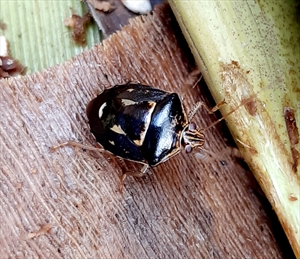- Narrow distribution. Southeast Asia (Singapore), Oceania. On coconut and betel nuts. It is not certain that this insect is the cause of the symptoms described below.
- Eggs laid in groups on flowers, on fibre at the base of the fronds, and on leaflets. Nymphs white, then orange and black. Adults, 15 mm long; strong smell when disturbed.
- Adults and nymphs use long mouth parts to suck sap of young coconuts. When bugs are numerous, young nuts fall, and those left are long and dry (i.e., without meat or milk). But it is NOT proven that the bug is the cause.
- Cultural control: Oecophylla ants will likely reduce numbers. Plant soursops, and when scale insects have established in the trees, place ant “nests” in the canopy.
- Chemical control: none recommended.






